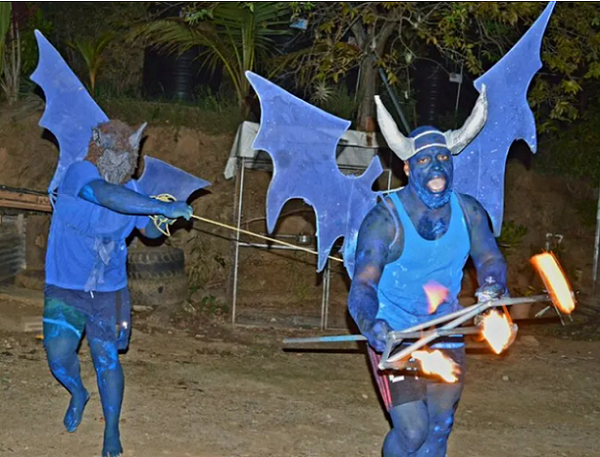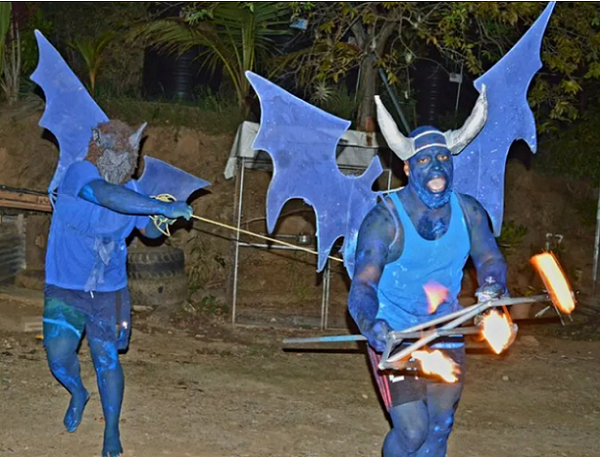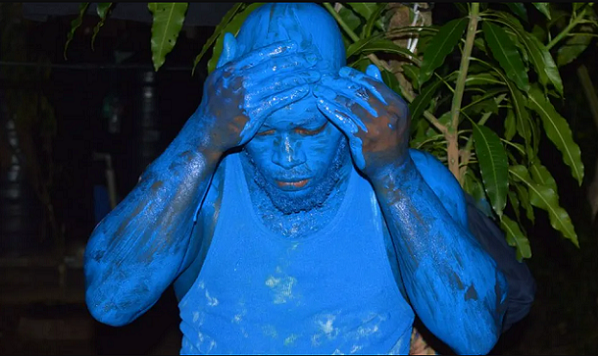
Although T&T’s major Mas took place earlier this month, here are excerpts from a captivating article on the Carnival’s “blue devils.” Anselm Gibbs reports from Paramin, Trinidad and Tobago, for BBC News (all photos by A. Gibbs.)
They are easy to spot among the rush of colour of the Trinidad and Tobago Carnival, their bodies covered in blue and their screams and antics somehow both frightening and fun.
They are blue devil masqueraders and they are fighting to keep a tradition alive.
It is a winding – and for visitors, at times, nerve-wracking – drive up steep hills to get to the remote village of Paramin, located in the north-western part of Trinidad.
Paramin is the home of the blue devil, a traditional Carnival character, according to local man Curdell Gibbs. “The only place in Trinidad and Tobago, and by extension the world, where you can find blue devils come Carnival Monday, is Paramin,” Curdell says.
The Caribbean nation celebrates Carnival annually on the Monday and Tuesday preceding Ash Wednesday. Costumed revellers participate in street parades and there is also competition among different masquerade groups or bands.
This year, Carnival organisers are expecting a high level of participation, but there is some concern. “A lot of the traditional characters appear in mini-bands and small bands, but there has been a decrease in the number of those,” the president of the Trinidad and Tobago Carnival Bands Association, Mark Ayen, tells BBC News. “They seem to be far fewer than what they have been before.”
Mark Ayen finds this alarming. He says that while the twin-island republic aims to develop its culture and Carnival, there must also be preservation.
On Carnival Monday night, when the hills of Paramin come alive with the annual blue devil masquerade competition, rhythms ring out from villagers with wooden sticks beating discarded metal biscuit tins. It’s called “knocking a pan” and provides the soundtrack for masqueraders.
[. . .] But Curdell warns that even in Paramin, where villagers say the heartbeat of the blue devil resides, fewer people are taking on the role. He believes it is because traditional Carnival elements are not as accessible as before. He wants to see more young people involved and says more exposure will help.
The origins of the devil masquerade – or “mas” for short – date all the way back to the days of slavery. The original term for devil mas is “Jab Molassie,” which is French patois for “Molasses Devil”. The name describes “the sticky black substance the character was covered in, which in the old days was molasses”, explains researcher, author and cultural activist Dr Rudolph Ottley. “Nowadays he could be covered in pitch oil [kerosene], mud, cocoa and come in a variety of colours like blue, red, green, silver etc,” he adds.
Freed slaves chose the devil to portray how they viewed slave owners, according to Mr Gibbs, who made his first appearance as a blue devil when he was just six years old. Eighteen years later, Curdell and a group of friends are part of a masquerade group called Next Generation Underworld Creepers.
The shiny blue coat covering their bodies is not paint. The colour actually comes from a process that starts with boiling water and grinding laundry-bluing cubes, which are usually used to wash white clothes. “Put it in a bucket, pour the water and then you mash some lard into it,” explains Leonardo Joseph, another member of Next Generation Underworld Creepers. “You let it cool, let it sit for a little while, so it turns into a paste.” Mixing this blue concoction begins as early as two days before it is rubbed on to the skin, according to Leonardo Joseph. For him, there is a bit of irony involved, as he is an altar server in the Roman Catholic church, yet he portrays the devil. “You have your faith, but you are portraying the culture you love,” Leonardo muses.
Leonardo and Curdell are trying to instill a love for that culture in the new generation. Their group has organised workshops, where youngsters can come to learn about blue devils and other aspects of Carnival, including wire-bending to make costumes.
It is part of their preservation push to save the traditional elements of Trinidad and Tobago’s Carnival. [. . .] These cultural crusaders have their work cut out for them. “The mas has been slowly but surely dying, it’s sad to see,” Curdell says. “I really feel the initiatives that we’re taking now, to bring the community together, will increase the traffic we have with blue devils.”
And the blue characters are something to behold: accessories for devil mas include horns, wings, a fork, a tail and anything else the masquerader wishes to add. Probably the most outstanding trick a blue devil has up his or her sleeve is fire-breathing. It involves filling your mouth with kerosene. “Everything you imagine the devil would do, we try to incorporate,” Curdell says. [. . .]
For full article and more photos, see https://www.bbc.com/news/world-latin-america-68250796
[All photos by Anselm Gibbs.]
Although T&T’s major Mas took place earlier this month, here are excerpts from a captivating article on the Carnival’s “blue devils.” Anselm Gibbs reports from Paramin, Trinidad and Tobago, for BBC News (all photos by A. Gibbs.) They are easy to spot among the rush of colour of the Trinidad and Tobago Carnival, their bodies








